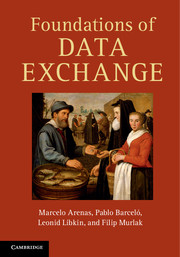Book contents
- Frontmatter
- Dedication
- Contents
- Preface
- Part One GETTING STARTED
- Part Two RELATIONAL DATA EXCHANGE
- Part Three XML DATA EXCHANGE
- 10 The problem of XML data exchange
- 11 Patterns and mappings
- 12 Building solutions
- 13 Answering tuple queries
- 14 XML-to-XML queries
- 15 XML data exchange via relations
- 16 Endnotes to Part Three
- Part Four METADATA MANAGEMENT
- References
- Index
10 - The problem of XML data exchange
from Part Three - XML DATA EXCHANGE
Published online by Cambridge University Press: 05 June 2014
- Frontmatter
- Dedication
- Contents
- Preface
- Part One GETTING STARTED
- Part Two RELATIONAL DATA EXCHANGE
- Part Three XML DATA EXCHANGE
- 10 The problem of XML data exchange
- 11 Patterns and mappings
- 12 Building solutions
- 13 Answering tuple queries
- 14 XML-to-XML queries
- 15 XML data exchange via relations
- 16 Endnotes to Part Three
- Part Four METADATA MANAGEMENT
- References
- Index
Summary
In this chapter we shall study data exchange for XML documents. XML itself was invented as a standard for data exchange on the Web, albeit under a different interpretation of the term “data exchange”. In the Web context, it typically refers to a common, flexible format that everyone agrees on, and that, therefore, facilitates the transfer of data between different sites and applications. When we speak of data exchange, we mean transforming databases under different schemas with respect to schema mapping rules, and querying the exchanged data.
XML documents and schemas
In this section we review the basic definitions regarding XML. Note that a simple example was already shown in Chapter 1. XML documents have a hierarchical structure, usually abstracted as a tree. An example is shown in Figure 10.1. This document contains information about rulers of European countries. Its structure is represented by a labeled tree; in this example, the labels are europe, country, and ruler. In the XML context, these are referred to as element types. We assume that the labels come from a finite labeling alphabet and correspond, roughly, to relation names from the classical relational setting.
The root of the tree is labeled europe, and it has two children that are labeled country. These have data values, given in parentheses: the first one is Scotland, and the second one is England. Each country in turn has a set of rulers.
Information
- Type
- Chapter
- Information
- Foundations of Data Exchange , pp. 135 - 142Publisher: Cambridge University PressPrint publication year: 2014
